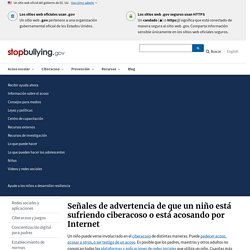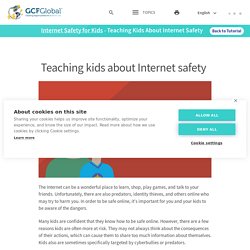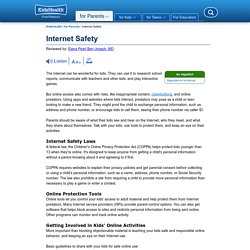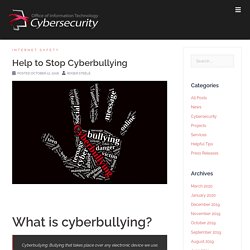

Some resources can be used as-is, while others may be better used for information collection and presented in a more condensed form. The rationale for the selection of each item is included in its comment section. Digital Citizenship in Education.
This resource was selected to help teachers and librarians learn how they can ensure digital citizenship is being practiced in their classrooms and libraries. – flpinckn
The 5 competencies of digital citizenship.
This was selected to give teachers and librarians more information about what digital citizenship is and how to teach students about it in a positive way. – flpinckn
Cyberbullying and the Public Librarian: What Can I Do to Help?
This list of cyberbullying resources was found through ALA.org. The intent is to assist public librarians with navigating the issue of cyberbullying but these sites can assist school librarians and teachers. – flpinckn
Cyberbullying - National Bullying Prevention Center. Just as the use of technology itself has evolved, so has the ability to bully. Bullying, once restricted to the school or neighborhood, has now moved into the online world. Bullying through the use of technology is referred to as “cyberbullying.” Cyberbullying is the use of technology to repeatedly and intentionally harass, hurt, embarrass, humiliate, or intimidate another person. As adults, thinking back, it was just a generation ago that kids and teens were asking their parents for a phone in their room — maybe even one with a separate line or three-way calling — so they could easily and somewhat privately connect with more friends. Today, a kid or teen’s desire to connect with friends has not changed, but the options for doing so have grown tremendously. Tips for Teachers. Señales de advertencia de que un niño está sufriendo ciberacoso o está acosando por Internet Un niño puede verse involucrado en el ciberacoso de distintas maneras.

Puede padecer acoso, acosar a otros, o ser testigo de un acoso. Es posible que los padres, maestros y otros adultos no conozcan todas las plataformas y aplicaciones de redes sociales que utiliza un niño. Cuantas más plataformas digitales utiliza un niño, se presentan más oportunidades de verse expuesto a un posible ciberacoso. Muchas de las señales de advertencia del ciberacoso ocurren cuando el niño utiliza su dispositivo. Aumento o disminución rápida y notable en el uso del dispositivo, inclusive la mensajería. Digital Awareness for Parents. The digital world is constantly evolving with new social media platforms, apps, and devices, and children and teens are often the first to use them.
This tool was selected to give librarians and teachers an idea of how to support parents with digital citizenship at home. – flpinckn
Some negative things that may occur include cyberbullying, sexting, posting hateful messages or content, and participating in negative group conversations.

If your child posts harmful or negative content online, it may not only harm other children; it can affect their online reputation, which can have negative implications for their employment or college admission. While you may not be able to monitor all of your child’s activities, there are things you can do to prevent cyberbullying and protect your child from harmful digital behavior: Monitor a teen’s social media sites, apps, and browsing history, if you have concerns that cyberbullying may be occurring.
Review or re-set your child’s phone location and privacy settings. Internet Safety for Kids: Teaching Kids About Internet Safety. Lesson 1: Teaching Kids About Internet Safety Teaching kids about Internet safety.

Internet Safety (for Parents) The Internet can be wonderful for kids.
Teachers and librarians can use this information as a handout or a guide when offering parents support digital citizenship with their children. – flpinckn
They can use it to research school reports, communicate with teachers and other kids, and play interactive games.

But online access also comes with risks, like inappropriate content, cyberbullying, and online predators. Using apps and websites where kids interact, predators may pose as a child or teen looking to make a new friend. They might prod the child to exchange personal information, such as address and phone number, or encourage kids to call them, seeing their phone number via caller ID. Parents should be aware of what their kids see and hear on the Internet, who they meet, and what they share about themselves.
Internet Safety Laws. Help to Stop Cyberbullying – OIT Cybersecurity. Cyberbullying: Bullying that takes place over any electronic device we use.

Its intent is to threaten, humiliate, harass or abuse another person. Cyberbullying can take place in any area of our online experience including text messages, games, apps, and social media. Cyberbullying focuses on sending or “posting” harmful or negative content in an effort to degrade or demean a person or group of people. Cyberbullying can be extremely devastating to the reputation and emotional well being of the person or group being targeted. Cyberbullying is extremely hard to combat. A few facts from dosomething.org Nearly 43% of kids have been bullied online. 1 in 4 has had it happen more than once.70% of students report seeing frequent online bullying.Over 80% of teens use a cell phone regularly, making it the most common medium for cyberbullying.
Cyberbullying is serious. It’s hard to help a victim of cyberbullying if you don’t know it is happening. Kids and Computer Security. FTC Consumer Information.